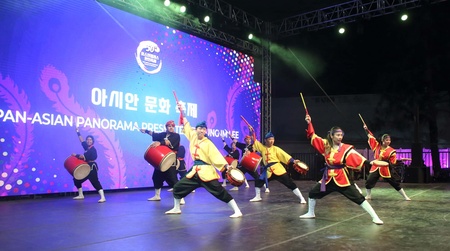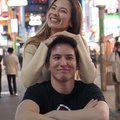On March 9, 2024, Discover Nikkei will host “Yeisaa nu Chimu-Don-Don: Exploring Cultural Identity through Okinawan Drumming,” a multilingual virtual program that will feature tutorials and conversations with members of contemporary eisa groups around the world. (Eisa is a traditional Okinawan folk dance and musical performance to honor the spirit of Okinawan ancestors.)
Ryukyukoku Matsuri Daiko Los Angeles Branch (RMDLA) will be one of the groups participating in this program. Discover Nikkei recently chatted with Stephanie Ajifu, the current Shibucho (Branch Leader) of this organization. With strong connections to Okinawan culture through her family and various community groups, Ajifu reflected on her Nikkei and Okinawan identities.
Okinawan Family Roots
Born and raised in Torrance, California, Stephanie Ajifu has lived there her entire life. She now attends college at Cal Poly Pomona. With both parents originally from Okinawa, she considers herself to be second generation Japanese-American.
“My father, Masanobu Ajifu, is from Kin-Cho in Okinawa. My mother, Nobuko Ajifu (née Shiraho), is from Hateruma, one of the Yaeyama islands and the southernmost inhabited island in Japan. My father’s family immigrated to Hawaii and California, but my mother’s family still lives in Okinawa,” Ajifu explained.
Ajifu remains connected to her grandparents and other family members in Okinawa. “My grandparents on my father’s side passed away before I was born. On my mother’s side, my grandpa still lives on Hateruma Island, along with my two uncles. My aunt lives in Tokyo. On my dad’s side, my aunt and uncle live in Oahu, Hawaii.” She added, “Since I am an only child and the youngest of my entire extended family, I try to visit Okinawa and spend time with family every summer, especially for Obon.”
Keeping Okinawan Culture Alive in the Ajifu Family
Ajifu’s family makes Okinawan culture part of their lives in different ways. “My mother cooks Okinawan dishes at home and in our backyard we grow goya and hechima (sponge gourd) or nabera which are traditional Okinawan vegetables,” noted Ajifu.

“My family observes Obon every August, usually traveling to Okinawa where we celebrate with family and friends. During Obon season, I sometimes perform Ryukyu buyo (dance) with my mother. My practice of traditional Okinawan buyo and taiko (drumming) is another way I keep my family’s culture and art alive.”
When asked about her language skills, she said, “I learned to speak Japanese by attending a Japanese language school every Saturday. Unfortunately, I don’t know how to speak Uchinaaguchi, the native Okinawan language. The Okinawa Association of America (OAA) offers Uchinaaguchi classes, and I would like to learn one day.”
What does Nikkei mean to you? Do you identify as Nikkei?
“To me, Nikkei means those who are of Japanese lineage and continue to embrace their culture. I consider myself Nikkei because I engage in and share Japanese experiences by being active in our community. For example, this past summer, I had the honor of interning for the Nikkei Community Internship (NCI) program that Kizuna offers for college students.
“Through NCI, I interned for the Gardena Valley Japanese Cultural Institute (GVJCI) and connected with folks of all ages to hear stories of their experiences in the Nikkei community.” (Kizuna is a community-based nonprofit organization in Little Tokyo, Los Angeles that provides cultural programs to educate and empower young community leaders.)
How has interacting with the Nikkei community affected you? What have you learned from these experiences?
“I learned that we are the next generation for empowering the Nikkei community and it’s up to us to shape the next generation of youth. Through the GVJCI internship, I gained a better understanding of Nikkei identity and the Japanese American community and our history. I learned more about our community’s history by touring the Japanese American National Museum and the Go for Broke Monument in Little Tokyo, both in Los Angeles, as well as visiting Japantowns in San Francisco and San Jose and their historical sites and monuments.”
Do you identify as “Okinawan”? What aspects of Okinawan culture do you feel most connected to?
“I identify as Okinawan because that is my blood and heritage,” said Ajifu. “I am inspired by how welcoming and friendly Okinawan folks are. They strive to be kind to all people, even if they don’t know them. They love to talk and listen to your stories. There is a famous saying, Ichariba choodee, which means ‘Once you meet, you are like brother and sister.’ The minute Okinawan folks meet you, they will treat you like family. Ichariba choodee inspires me to be warm and friendly to others, too.”
“Another inspiring Okinawan saying is Nankurunaisa, meaning ‘everything will be okay.’ In other words, do not stress and worry too much, as everything will be okay as long as you take it one day at a time and appreciate the things you have right now.”
How have you participated in your Okinawan community?
“I grew up volunteering for local events through the Okinawa Association of America (OAA) in Gardena. I began practicing Ryukyu buyo, traditional Okinawan dancing, when I was four. When I was ten, I started eisa, Okinawan drumming. I continue both practices to this day, and I practice Ryukyu buyo with my mother.”
In 2021 she went to Okinawa through the government-sponsored Junior Study Program for young adults. In 2023 Ajifu was awarded a Nanka Kenjinkai Engeikai Scholarship for Ryukyu buyo.
Ryukyukoku Matsuri Daiko Los Angeles (RMDLA)
Please tell us a little about Ryukyukoku Matsuri Daiko.
“Ryukyukoku Matsuri Daiko literally translates to ‘Ryukyu Kingdom Festival Drums.’ Ryukyu Kingdom is the ancient name for what is now known as Okinawa prefecture of Japan. Located southwest of mainland Japan and northeast of Taiwan, Ryukyu consists of about fifty islands, of which Okinawa is the largest. Due to its location, Okinawa’s culture and traditions have been influenced not only by Japan, but also China, Korea and southeast Asia. Ryukyukoku Matsuri Daiko is modeled on the traditional Okinawan obon festival drum dancing called eisa.”
What are the organization’s musical and performance styles?
“The performers dance and drum simultaneously to an exciting blend of traditional and contemporary Okinawan and Japanese music. The group performs with several types of drums: the odaiko (big drum), which is suspended in front of the body by long pieces of purple cloth over the shoulder and back, the shime-daiko (hand-held, flat, two-sided drum), and the paranku (hand-held, flat, one-sided drum). RMD made popular a more contemporary form of eisa that incorporates sharper karate-style movements, unlike the more fluid free-form style of traditional eisa.”
What is the origin of the organization? How was it formed?
“Ryukyukoku Matsuri Daiko formed in Okinawa in 1982 to encourage local youth to take part in the traditional form of festival drumming called eisa. Since its formation, RMD has formed many branches around the world to spread eisa to wherever Okinawan roots have taken hold. It also has chapters in mainland Japan, South America, and many states across the US.
“The Los Angeles branch of RMD was formed in 1995 under the guidance and financial support of the Okinawa Association of America (OAA) Geinobu (Cultural Arts Division). Doreen Whiteley, Aiko Majikina, and Yasukazu Takushi were the founders. Aiko Majikina asked the headquarters in Okinawa for permission to form a Ryukyukoku Matsuri Daiko branch overseas, and LA became the first overseas group. In 2025 we will be celebrating our 30th Anniversary.”
How does RMD participate in the LA community?
“We perform at festivals and/or Japanese events in the SoCal region. We have performed at venues such as The Grove, Nisei Week Grand Parade, Taiko Gathering, Coronation Ball, Cherry Blossom Festival in Monterey Park, Japan Expo Los Angeles, and the Los Angeles County Fair. Representing Japan Day, we have also performed at Dodgers Stadium and the halftime show for a Clippers basketball game. In 2023, we had the honor of performing for Anime Expo in Los Angeles.”
How have your audiences reacted to RMDLA’s performances? What impact do you think your performances have had on the LA community?
“In 2015 we celebrated our 20th anniversary by performing our show, Uchinaa Chimu Don Don, which translates to ‘the heartbeat of Okinawa.’ I think this exactly reflects what Okinawan taiko/eisa is. The beat of the drums communicates the heartbeat of Okinawan art and is keeping the culture alive all across the world.
“Some of the members in our group are not Okinawan. I like to believe that they joined RMDLA because they were moved by our style of drumming, dancing to Okinawan music, and chanting Okinawan callings/sayings, called heishi. By combining these three aspects of Okinawan performance, our group can share the richness of Okinawan culture with the Nikkei and LA communities and inspire the next generation of Nikkei youth to continue our traditions.”
As RMDLA’s current Shibucho (Branch Leader), how do you interact with members to provide guidance and leadership? What have you learned in your role?
“I strive to have open and honest communication with our ‘taiko family’. I try to practice ichariba choodee when welcoming new members. Most members range in age from ten to 18. I have learned that no matter the age or experience, everyone can help you learn something. Whether it is the new beginner members or the older members in our group, with each interaction, I am constantly learning and growing as an individual.
“We are all friends outside of eisa. We celebrate holidays together like our annual Christmas party and enjoy team bonding activities, such as ice skating and beach days. A current goal is to prepare for our 30th anniversary show that is scheduled for October 2025.”
How has your involvement with eisa and RMDLA impacted your identity and connections to your cultural heritage?
“I feel a much stronger connection to my Okinawan roots by being active in the community and the arts, especially because many of my family members live far away and I only see them once a year. I treasure eisa more because it connects me to my family.
“My worldview has been positively impacted, as being involved with eisa has inspired my interest in other cultures. I feel pride in being able to perform and share the beauty of Okinawan art here in Southern California, and I hope to continue doing so.”
(All photos are courtesy of Stephanie Ajifu)
* * * * *
Saturday, March 9, 2024 • 3 p.m. PST (ZOOM)
Join us for a conversation and Q&A with members of contemporary eisa groups—Lisa Tamashiro Maumalanga (Chinagu Eisa Hawaii), Rentaro Suzuki (Ryukyukoku Matsuri Daiko Los Angeles Branch), John Azama (Ryukyu Damashii), Cecilia Nué (Seiryu Eisa Kai), and Toshiyuki Yamauchi (Yuriki no Kizuna Eisá Daiko)—as they discuss how eisa connects them to their cultural heritage and identity. An interactive beginners tutorial and opportunity to talk with members from various eisa groups will follow the program.
The main program will be presented via Zoom, with simultaneous translation in English, Spanish, and Portuguese. Registration is required.
© 2024 Karen Kawaguchi

















